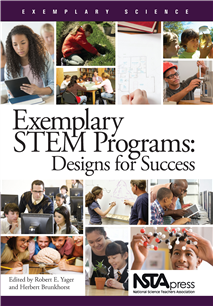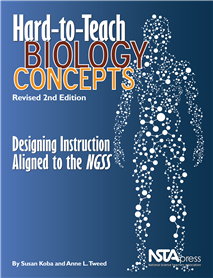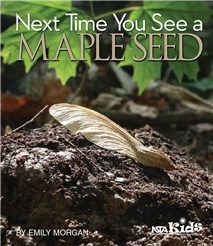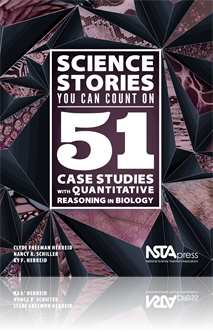All Book Chapters
Book Chapter
STEM Education in the Middle School Classroom
In this chapter, find out how STEM lessons were first incorporated into a sixth-grade classroom in the Lebanon Special School District, a small community in Middle Tennessee. These students never gave much thought to careers in the STEM field. When c...
Book Chapter
Have you ever rubbed a balloon on your clothes or your hair? What happened? Perhaps you noticed that the balloon somehow made your hair stand up. Maybe you could then stick the balloon to a wall or a ceiling. This phenomenon is called static electri...
Book Chapter
Matter and Energy in Organisms and Ecosystems
The big idea for an area of study that challenges students year after year but yet is essential to life processes is the relationship between matter and energy—how we get and use energy for life. If we put a phrase to this, it is all about cellular...
Book Chapter
Next Time You See a Maple Seed sample
The Next Time You See books are not meant to present facts to be memorized. They are written to inspire a sense of wonder about nature and foster a desire to learn more about the natural world. In this free sample chapter from the Next Time You See a...
Book Chapter
Phenomenon-based learning (PBL) is built on observations of real-world phenomena. PBL is not so much a teaching method as it is a route to grasping the big picture and is an approach that is fun and interesting for both teachers and students. In this...
Book Chapter
Friction is very common and experienced every day. It is a force that pushes on things and that you notice when two objects’ surfaces are in contact with each other. Air resistance is a force that occurs because moving objects hit the air in front ...
Book Chapter
There is always a force between the Earth and other masses. This force is called gravity or gravitation. Gravity affects all objects on Earth. It doesn’t matter if they are on the ground or in the air. In this chapter, the experiments focus on how ...
Book Chapter
Gravity pulls the air molecules toward the ground, and the molecules push on the ground. This pushing is called air pressure or atmospheric pressure. In this chapter’s experiments, students will learn about air pressure and the meaning of terms suc...
Book Chapter
All electrical gadgets and gizmos need an electric current to work. To make it easier to learn about and make circuits, you will need to know the symbols for some components. In this chapter, you will learn about these symbols and then plan and build...
Book Chapter
A magnet attracts objects made of iron and this phenomenon called magnetism has many uses. In this chapter, you will explore and experiment with magnetism in different ways, including bar magnet, magnetic field, magnetic globe, and electromagnet. Tea...
Book Chapter
Energy is everywhere in several different forms and can be moved from place to place in many ways. In these experiments, you will find out more about what energy is, how it can be transported, and how is it possible to transform energy to different f...
Book Chapter
In everyday life we often talk about pressure—high pressure and low pressure. We speak of the pressure in car tires, atmospheric pressure, pressure-sealed containers, pressure chambers, and so on. These are just a few of the ways we encounter press...
Book Chapter
Thermodynamics is the physics of heat, mechanical energy or work, and the conversion of one into the other. All systems follow the laws of thermodynamics and since almost all energy production is based on thermodynamics, it is important to understand...
Book Chapter
Energy is an essential part of all branches of physics. In mechanics, energy appears as both potential and kinetic energy. In this chapter, the experiments examine the conservation of energy and how energy can change from one type to another. Teacher...
Book Chapter
Color theory is an area of physics that can explain how the appearance of colors changes when colors are mixed, for example on a computer screen or with a printing press. Visible light can be divided into different ranges of wavelengths, which we see...
Book Chapter
Resonance—a system’s tendency to oscillate at greater amplitudes at certain frequencies—is a common phenomenon in physics. The explorations in this chapter will define how resonance occurs. Teacher background information, assessment, safety not...
Book Chapter
Buoyancy is a phenomenon that occurs not only in water but also in the atmosphere. The effect of buoyancy is easily felt in water. A hot air balloon rises up in the air because of a buoyant force from the air around it and the principle of buoyancy c...
Book Chapter
The concept of angular momentum can be related to linear momentum. The difference is that while linear momentum occurs with motion in a straight line, angular momentum applies to circular motion. The observations in this chapter cover the law of cons...
Book Chapter
Magnetism is a well known physics phenomenon that is used, for example, in computers for magnetic recording, in Maglev trains, or for holding notes on a refrigerator door. Magnetism is a phenomenon in which the magnetic materials interact with one an...
Book Chapter
Electromagnetic induction is the basis for producing energy in our society. This phenomenon is used in wind generators, hydroelectric generators, and nuclear power plants, as well as in metal detectors, induction brakes, and transformers. In this cha...
Book Chapter
In this chapter, you will find explorations on gadgets that are very interesting and illustrative but that do not fit into the other chapters. However, many of these gadgets complement the explorations in earlier chapters. Teacher background informat...
Book Chapter
Rubber vs. Glass: I Wonder Why sample
In this sample from Rubber vs. Glass: I Wonder Why you will explore the properties of rubber vs. glass and will discover that different objects have special and useful properties. ...
Book Chapter
Light and Color: I Wonder Why sample
This sample from Light and Color: I Wonder Why unfolds observations about light, interaction with the properties of light, and the effect of light on objects. By reading this sample, you’ll discover what we mean when we say the colors of a rainbow...
Book Chapter
Sounds Are High, Sounds Are Low: I Wonder Why (Book Sample)
This sample from Sounds Are High, Sounds Are Low: I Wonder Why presents the nature of waves and sound with humorous proof in poetry of just how fun it is to observe with your ears. It’s ideal for beginning readers and hilarious practice for future...
Book Chapter
Michael's Racing Machine: I Wonder Why sample
This sample from Michael’s Racing Machine: I Wonder Why illustrates the use of simple machines to accomplish work. It provides an easy-to-understand lesson in how simple machines are all around us, making work more efficient. You will learn that a ...
Book Chapter
Dark as a Shadow: I Wonder Why sample
This sample from Dark as a Shadow: I Wonder Why is written in lively rhymes, making it fun to learn the science behind why shadows change length through the day and disappear in the dark. Kids will learn to twist and bend or wiggle and shake, to see...
Book Chapter
Next Time You See The Moon sample
This sample chapter from Next Time You See The Moon focuses on the Moon's changing shapes and the many phases of the Moon. If you keep track of the Moon phases for a while, you will discover that it takes about a month to observe all of the Moon phas...
Book Chapter
A Can of Bull? Do Energy Drinks Really Provide a Source of Energy?
The case in this chapter teaches students about large biomolecules, nutrition, and product analysis. Students conduct a biochemical analysis of several popular energy drinks on the market and determine whether these products nutritionally match their...
Book Chapter
The purpose of this lab investigation is to introduce the concept of osmosis and help students understand “Why Do Red Blood Cells Appear Bigger After Being Exposed to Distilled Water?” This lab investigation will also help students learn how to ...
Book Chapter
The purpose of this lab investigation is for students to apply what they know about the characteristics of plant and animal cells to classify an unknown single-celled organism and to determine “How Should the Unknown Microscopic Organism Be Classif...
Book Chapter
The purpose of this lab investigation is for students to apply what they know about the process of cell division to determine “Do Plant and Animal Cells Spend the Same Proportion of Time in Each Stage of the Cell Cycle?” Students will also learn...
Book Chapter
Normal and Abnormal Cell Division
The purpose of this lab is for students to apply their understanding of cell division to solve a problem that requires them to examine the cellular structure of tissues and diagnose a disease and to determine "Which of These Patients Could Have Cance...
Book Chapter
The purpose of this lab is for students to apply their understanding of the process of photosynthesis to determine “Why Do Temperature and Light Intensity Affect the Rate of Photosynthesis in Plants?” This lab also gives students an opportunity ...
Book Chapter
The purpose of this lab is for students to apply their understanding of the processes of cellular respiration to determine “How Does the Type of Food Source Affect the Rate of Cellular Respiration in Yeast?” The lab also gives students an opport...
Book Chapter
The purpose of this lab is for students to apply their understanding of transpiration in plants to determine ”How Does Leaf Surface Area Affect the Movement of Water Through a Plant?” The lab also gives students an opportunity to design and carry...
Book Chapter
The purpose of this lab is for students to apply what they know about the function of enzymes to determine ”How Do Changes in Temperature and pH Levels Affect Enzyme Activity?” The lab also gives students an opportunity to design and carry out a ...
Book Chapter
The purpose of this lab is to introduce students to how population size changes over time and to determine ”How Do Changes in the Amount and Nature of the Plant Life Available in an Ecosystem Influence Herbivore Population Growth Over Time?” The ...
Book Chapter
Predator-Prey Population Size Relationships
The purpose of this lab is to introduce students to the concept of a predator-prey population size relationship and to determine ”Which Factors Affect the Stability of a Predator-Prey Population Size Relationship?” The lab also gives students an ...
Book Chapter
The purpose of this lab is to introduce students to the concepts of ecosystems, food chains, food webs, and biodiversity, and to determine ”How Does Food Web Complexity Affect the Biodiversity of an Ecosystem?” The lab also gives students an oppo...
Book Chapter
Environmental Influences on Animal Behavior
The purpose of this lab is for students to apply what they know about animal behavior and the interactions among species and their environment to determine ”How Has Climate Change Affected Bird Migration?” The lab also gives students an opportuni...















